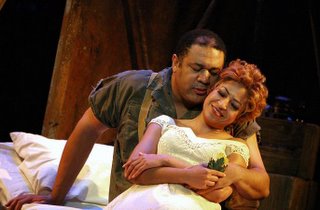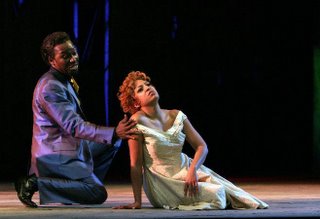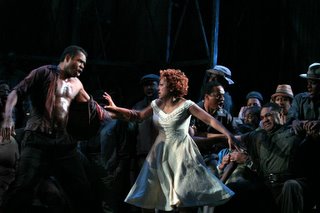I's Sat's through Porgy
 Porgy and Bess (1935) – surprisingly – has not been shown at the Washington National Opera before, despite having a significant history in town. Perhaps that’s because it inhabits a space just between that which is opera and that which isn’t. It’s like ethnic Broadway hurled onto the opera stage, but with everything a bit bigger and better than Broadway. It feels more like a well-liked guest at an opera house, rather than an opera itself. But then again, if Floyd’s (very fine) Susannah is considered a full-fledged opera, why not Porgy? Certainly its story isn’t less nuanced. In any case, it does not matter what I think it is or isn’t since the potential audience knows Porgy and whether they will like it or not. Many do – as the well-filled Kennedy Center Opera House proved. And why not? It offers some great music – and if that is wedged between patronizingly racial and misogynist anachronisms, well, you get twice that on each count in Die Zauberflöte.
Porgy and Bess (1935) – surprisingly – has not been shown at the Washington National Opera before, despite having a significant history in town. Perhaps that’s because it inhabits a space just between that which is opera and that which isn’t. It’s like ethnic Broadway hurled onto the opera stage, but with everything a bit bigger and better than Broadway. It feels more like a well-liked guest at an opera house, rather than an opera itself. But then again, if Floyd’s (very fine) Susannah is considered a full-fledged opera, why not Porgy? Certainly its story isn’t less nuanced. In any case, it does not matter what I think it is or isn’t since the potential audience knows Porgy and whether they will like it or not. Many do – as the well-filled Kennedy Center Opera House proved. And why not? It offers some great music – and if that is wedged between patronizingly racial and misogynist anachronisms, well, you get twice that on each count in Die Zauberflöte.
Charles T. Downey, DCist Goes to the Opera (DCist, November 4) Tim Page, 'Porgy': Heaven the Whole Night Long (Washington Post, October 31) National Opera Defines 'Porgy' (Washington Times, October 31) Ben Mattison, Photo Journal: Porgy and Bess at Washington National Opera (Playbill Arts, October 31) Jacqueline Trescott, The Baritone's Deeper Resonance (Washington Post, October 29) |
 The main cast of Porgy and Bess is, by Gershwin’s fiat, all black – and thankfully the chorus was (with two well blended-in exceptions), too. It added much to the feel and believability of the setting and story. Fortunately political correctness has not yet gone so far that there was an unspoken need present to place a random white face into the Catfish Row community. It would have been as odd as a Desi mug in the Rosenkavalier entourage – only that the latter can’t seriously be objected to these days… for the better of society perhaps, if for the worse of the Viennese feel of the Rosenkavalier.
The main cast of Porgy and Bess is, by Gershwin’s fiat, all black – and thankfully the chorus was (with two well blended-in exceptions), too. It added much to the feel and believability of the setting and story. Fortunately political correctness has not yet gone so far that there was an unspoken need present to place a random white face into the Catfish Row community. It would have been as odd as a Desi mug in the Rosenkavalier entourage – only that the latter can’t seriously be objected to these days… for the better of society perhaps, if for the worse of the Viennese feel of the Rosenkavalier.The vocal contributions on Wednesday ranged from “fine” to “excellent” – and although they had declined from the earlier performance I had heard, they sang with at times infectious enthusiasm. From a cast without major weaknesses, the following stood out: Terry Cook’s strong, indefatigable Crown, Indira Mahajan’s soaring and swinging Bess, George Ingram III in the small role of Mingo. Gordon Hawkins – the Porgy of the November 6th, 10th, 12th, 15th, and 18th productions – was completely exhausted by the end of the opera; visibly and audibly so. His rest on November 5th, 7th, 15th, and 19th, when Kevin Gladen will take over, is not only well deserved but surely most welcome on his part. Laquita Mitchell’s Summertime opened the work in style while her on-stage husband Jim, sung by the strapping Robert Cantrell, was impressive without being imposing and a slight sense of vocal fatigue noticeable.
 The orchestra performed with all the requisite groove and flair under the Porgy-experienced British conductor Wayne Marshall. The banjo plucked by Michael Decker and the saxophone and clarinet sections were a particular delight. It’s perhaps easy to have a problem with Porgy and Bess itself, but it would be difficult to find much fault in this performance.
The orchestra performed with all the requisite groove and flair under the Porgy-experienced British conductor Wayne Marshall. The banjo plucked by Michael Decker and the saxophone and clarinet sections were a particular delight. It’s perhaps easy to have a problem with Porgy and Bess itself, but it would be difficult to find much fault in this performance.The WNO production continues until November 19, with a free broadcast of the November 6 performance to be shown live on a giant video screen near the Capitol on the National Mall on Sunday, November 6 at 2 pm. That event is free.




















































